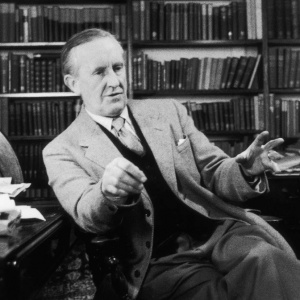Beowulf: Tolkien John Ronald Reuel
The translation of Beowulf by J.R.R. Tolkien was an early work, very distinctive in its mode, completed in 1926: he returned to it later to make hasty corrections, but seems never to have considered its publication.
This edition is twofold, for there exists an illuminating commentary on the t
This edition is twofold, for there exists an illuminating commentary on the t
Полная аннотация
Издательство
Все характеристики
Аннотация
The translation of Beowulf by J.R.R. Tolkien was an early work, very distinctive in its mode, completed in 1926: he returned to it later to make hasty corrections, but seems never to have considered its publication.
This edition is twofold, for there exists an illuminating commentary on the text of the poem by the translator himself, in the written form of a series of lectures given at Oxford in the 1930s; and from these lectures a substantial selection has been made, to form also a commentary on the translation in this book.
From his creative attention to detail in these lectures there arises a sense of the immediacy and clarity of his vision. It is as if he entered into the imagined past: standing beside Beowulf and his men shaking out their mail-shirts as they beached their ship on the coast of Denmark, listening to the rising anger of Beowulf at the taunting of Unferth, or looking up in amazement at Grendel’s terrible hand set under the roof of Heorot.
But the commentary in this book includes also much from those lectures in which, while always anchored in the text, he expressed his wider perceptions. He looks closely at the dragon that would slay Beowulf ‘snuffling in baffled rage and injured greed when he discovers the theft of the cup’; but he rebuts the notion that this is ‘a mere treasure story’, ‘just another dragon tale’. He turns to the lines that tell of the burying of the golden things long ago, and observes that it is ‘the feeling for the treasure itself, this sad history’ that raises it to another level. ‘The whole thing is sombre, tragic, sinister, curiously real. The “treasure” is not just some lucky wealth that will enable the finder to have a good time, or marry the princess. It is laden with history, leading back into the dark heathen ages beyond the memory of song, but not beyond the reach of imagination.’
Sellic Spell, a ‘marvellous tale’, is a story written by Tolkien suggesting what might have been the form and style of an Old English folk-tale of Beowulf, in which there was no association with the ‘historical legends’ of the Northern kingdoms.
This edition is twofold, for there exists an illuminating commentary on the text of the poem by the translator himself, in the written form of a series of lectures given at Oxford in the 1930s; and from these lectures a substantial selection has been made, to form also a commentary on the translation in this book.
From his creative attention to detail in these lectures there arises a sense of the immediacy and clarity of his vision. It is as if he entered into the imagined past: standing beside Beowulf and his men shaking out their mail-shirts as they beached their ship on the coast of Denmark, listening to the rising anger of Beowulf at the taunting of Unferth, or looking up in amazement at Grendel’s terrible hand set under the roof of Heorot.
But the commentary in this book includes also much from those lectures in which, while always anchored in the text, he expressed his wider perceptions. He looks closely at the dragon that would slay Beowulf ‘snuffling in baffled rage and injured greed when he discovers the theft of the cup’; but he rebuts the notion that this is ‘a mere treasure story’, ‘just another dragon tale’. He turns to the lines that tell of the burying of the golden things long ago, and observes that it is ‘the feeling for the treasure itself, this sad history’ that raises it to another level. ‘The whole thing is sombre, tragic, sinister, curiously real. The “treasure” is not just some lucky wealth that will enable the finder to have a good time, or marry the princess. It is laden with history, leading back into the dark heathen ages beyond the memory of song, but not beyond the reach of imagination.’
Sellic Spell, a ‘marvellous tale’, is a story written by Tolkien suggesting what might have been the form and style of an Old English folk-tale of Beowulf, in which there was no association with the ‘historical legends’ of the Northern kingdoms.
Свернуть
Характеристики
Издательство
ID товара
897342
ISBN
9780007590070
Язык
Английский
Страниц
425 (Офсет)
Вес
1282 г
Размеры
305x165x55 мм
Тип обложки
Box
Оформление
Тиснение золотом, футляр открытый
Иллюстрации
Без иллюстраций
Все характеристики
20 653
Рецензии на книгу
Читали книгу? Как она вам?
+50 ₽ за рецензию
Вы можете стать одним из первых, кто напишет рецензию на эту книгу, и получить бонус — до 50 рублей на баланс в Лабиринте!
Покупатели 0
Эксперты 1
Книги автора Tolkien John Ronald Reuel
Книги из жанра
1 9884 418 -55% Еще 19 дней
9 29420 653 -55% Еще 19 дней
The Fall of Numenor and Other Tales from the Second Age of Middle-earth. Deluxe Edition
Tolkien John Ronald Reuel1 3762 752 -50% Еще 22 дня
Bodies from the Library 5. Lost Tales of Mystery and Suspense from the Golden Age of Detection
Sayers Dorothy Leigh10 32720 653 -50% Еще 22 дня
The Battle of Maldon. Together with The Homecoming of Beorhtnoth. Deluxe Edition
Tolkien John Ronald Reuel2 2104 911 -55% Еще 19 дней
Что читать вместе с книгой "Beowulf"

Издательство HarperCollins: дом драконов, хоббитов и не только
Август 2023 •  5 455
5 455

Традиция и хоббиты. Как Толкину удалось создать идеальный фантастический мир
Сентябрь 2022 •  20 205
20 205

Наследник Средиземья. Жизнь Кристофера Толкина
Январь 2020 •  10 252
10 252


